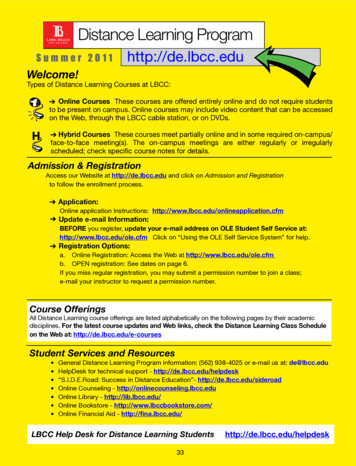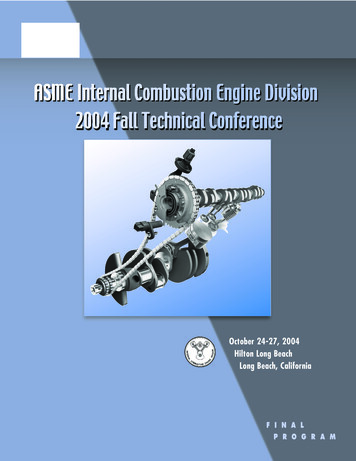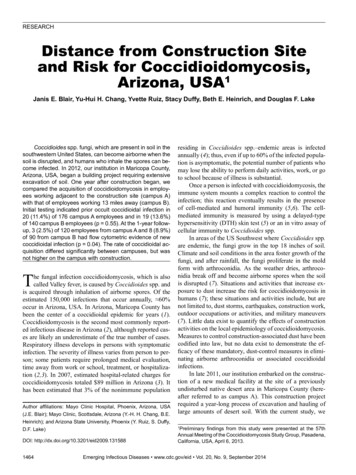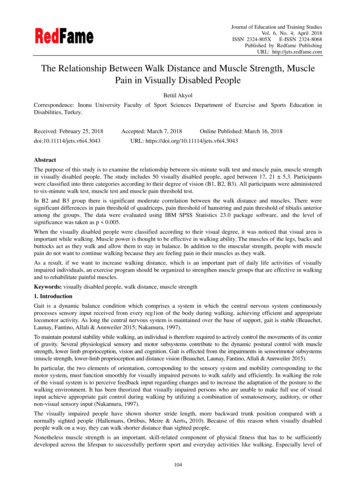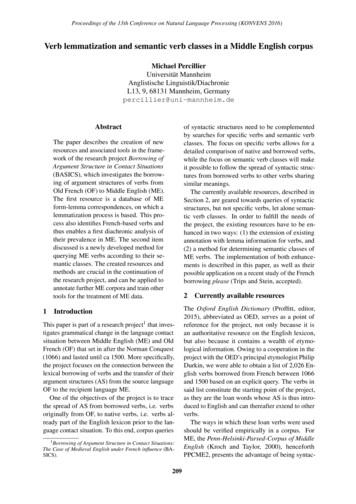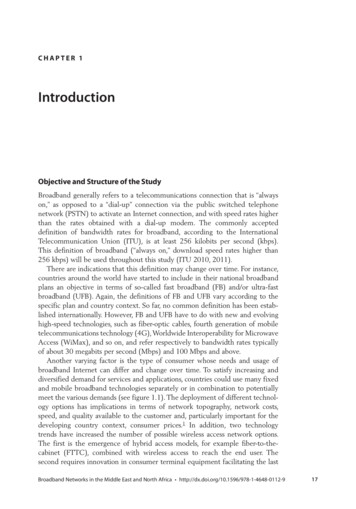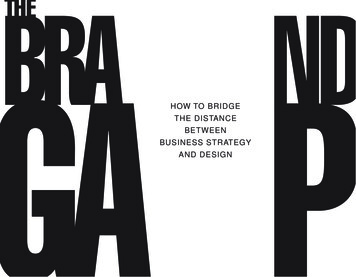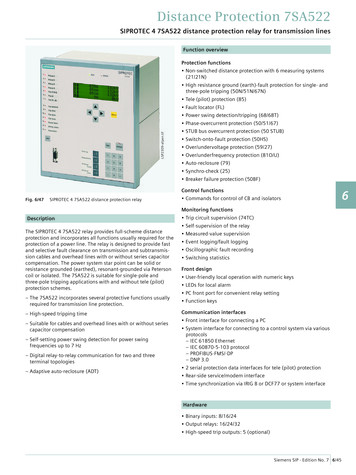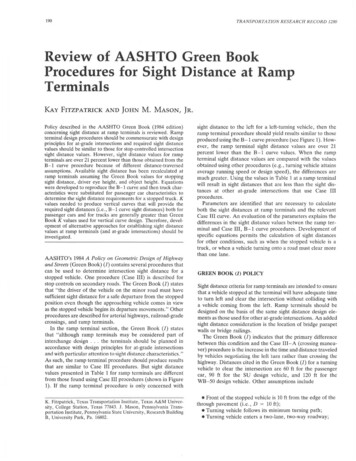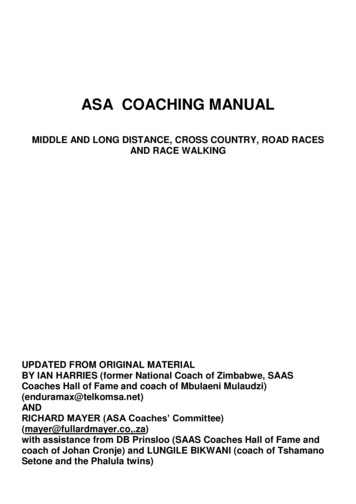
Transcription
ASA COACHING MANUALMIDDLE AND LONG DISTANCE, CROSS COUNTRY, ROAD RACESAND RACE WALKINGUPDATED FROM ORIGINAL MATERIALBY IAN HARRIES (former National Coach of Zimbabwe, SAASCoaches Hall of Fame and coach of Mbulaeni Mulaudzi)(enduramax@telkomsa.net)ANDRICHARD MAYER (ASA Coaches’ Committee)(mayer@fullardmayer.co,.za)with assistance from DB Prinsloo (SAAS Coaches Hall of Fame andcoach of Johan Cronje) and LUNGILE BIKWANI (coach of TshamanoSetone and the Phalula twins)
2CONTENTS1. Introduction2. General Training Principles3. Talent Identification4. Biomechanics of Distance Running5. Energy Systems6. Periodisation7. Technique for running events8. Technique for steeple chase9. Technique for race walking10. Race tactics10.1Track events10.2Cross Country10.3Road races11. Physiological aspects of training12. Muscle endurance13. Speed endurance14. Strength training15. Drills to develop technique of race walkers16. Warming up before workout17. Stretching exercises18. Training Programmes for the various distances18.1800m18.21200m/1500m18.32000m/3000m Steeplechase18.43000m/5000m/10 000m & Cross Country18.5Road Running & Marathon19. Rules of Competition & training guidelines20. How to Peak for a Championship21. Relaxation22. Rest and the law of Overload23. Bibliography of Recommended 556166687073
3GUIDELINES FOR COACHINGGENERAL1. INTRODUCTIONIn order to be able to understand and apply the basic training principlesrelating to distance running, it is important to be aware of general trainingprinciples and of the specific characteristics of distance athletes.The goal of this training manual is to familiarise the beginner coach withthe main energy systems involved in exercise and the various trainingsessions which can be used to develop these energy systems. It alsoprovides the beginner coach with training guidelines and suggestedtraining schedules for training athletes.All students of physics have heard of Isaac Newton’s laws of motion butbut of more direct relevance to distance running are Arthur Newton’slaws of running which may be found with a very useful commentary inevery edition of Tim Noakes, The Lore of Running, and on the Internet.Arthur Newton was a famous South African ultra-marathon athlete whowon the Comrades five times in the 1920s. His nine rules of trainingare: Train frequently all year roundStart gradually and train gentlyTrain first for distance (only later for speed)Don’t set yourself a daily schedule (adjust training according tohow the athlete is feeling on the day)Don’t race in training and run time-trials and races longer than16km only infrequentlySpecialise (that is, devote enough time to training)Don’t over trainTrain the mindRest-up before the race.
42. TALENT IDENTIFICATIONThe human body form is divided into three basic types: Mesomorphs – strongly built, well-muscled individuals who tendto be sprinters and rugby playersEctomorphs – thin, slightly built individualsEndomorphs – heavier individuals who at times suffer fromobesity and who tend to be swimmers and field event athletes.Distance runners are generally smaller and thinner than the averageperson and correspond to the ectomorph category above.Nevertheless, build aside, probably the most important consideration indetermining whether a runner is best suited to sprinting or middledistance running is basic speed. One can test this by getting an athleteto take a 30 meter sprint from a standing start.Those who can run the distance in 3 to 5 seconds (depending onage) can be genuine sprinters, while those who are slower must settle forbeing middle and longdistance athletes because they do not have thebasic speed to have any chance of success in competitive sprinting.3. BIOMECHANICS OF THE DISTANCE RUNNINGIt is generally inadvisable to attempt to change the running style of anathlete. Never the less strength and stretching exercises under thesupervision of a trained bio-kineticist (someone trained in humanmovement studies) can help correct biomechanical imbalances whichnegatively affect an athlete’s style and can lead to injury.When an athlete has reached a good level of fitness through regulartraining, the athlete should be encouraged to focus on relaxation inracing and training. This is achieved by keeping arms low and keepingthe jaw relaxed. This is achieved by asking the athlete to feel the skinbouncing on the cheeks when running. Clenched jaws and gritted teethare to be avoided.The secret of success in all sporting endeavour, although it might take an
5entire sporting career to achieve the desired balance, is to be totallyrelaxed while giving 100 % effort.5. ENERGY SYSTEMS AEROBIC––External source, ie the oxygen that is breathed in.This occurs when an athlete runs comfortably at moderateto medium effort at a pace at which talking is possible.This is the most important aspect of the training of middleand long - distance athletes. ANAEROBIC––Exhausts external sources.Obtains energy internallyOperative when athlete’s body is performing at a level of intensity atwhich not all the athlete’s energy requirements can be satisfied byoxygen obtained via the lungs. ALACTIC (0 – 6 SECONDS) – primary energy system operative inrunning at maximum speed––––– High intensityActivity up to 6 seconds (about 50 m)Draws reserves from musclesRecovers after 2 – 3 minutesRecovery capacity can be developedLACTIC ( 7 – 38 SECONDS)–––At intense levels of exercise the oxygen needs of theathlete’s body exceed the capacity of the body to supplyoxygenToxins in the form of lactic acid build upThis causes muscle fatigue (evident in last 100 meters of a400 meters race)
6––––––6.Speed decreases after about 250 meters of sprintingRecovery occurs after 60 minutesRecovery capacity developed – training from 7 - 38 secondsHigher intensity higher lactic acid build - upLight movement through jogging enhances recoveryThis is why is important to jog about 2 km after a race oranaerobic training session.PERIODISATION1.TERMINOLOGY Short term cycle (3 – 12 months) divided into: MicroMesoMacro1 week3 – 9 weeksseasonMedium term ( 1 – 2 years)Long term (3 – 4 years) – the Olympic cycle is 4 years2. CYCLES PREPARATION 1 (WINTER) GENERAL CONDITIONING Volume high Intensity low Rest short Non specificThis training phase is characterised by easy aerobic runningof between 5 to 10 minutes (for beginners of 6 years and updepending on fitness) to regular runs of 90 to 120 minutes forelite senior athletes. In the case of marathon and ultramarathon athletes the duration can be up to 3 hours.
7 STRENGTH AND PRE-SEASON PHASE (6 weeks) Shift to more specific conditioningExercises more specific to eventStrength developed through hill sessions andPlyometric exercises such as bounding and hillspringingVolume still highIntensity lower but strength exercises introduceAnaerobic element into trainingRest shortRunning exercises to promote efficiency and styleSuch as 6 to 10 relaxed 100 metre strides anddownhill running, In this phase the emphasis is on strength as a transition toand preparation for anaerobic work in the co-ordinationphase that follows. PREPARATION 2 (Pre – competition phase) (Co-ordinationphase) Training for competitionVolume decreasesIntensity increases – anaerobic track sessions introducedRest still shortTechnique emphasisedFocus on co-ordination of different training aspects foroptimal results in competition phase, namely: StrengthEnduranceSpeed / RhythmTechnique
8 COMPETITION PHASE (6 to 8 weeks) Focus on competition – 5 to 6 weekly races before targetraceVolume low – less emphasis on long aerobic runningIntensity high – less training reps than in co-ordination phasebut at greater intensityStabilise performance in competition and ensure body isfreshPsychological Preparation through visualisation for peakperformanceThe key to this phase is the principle that is impossible to trainhard and race well at the same time – volume of training in termsof kilometers are decreased and the goal is to ensure the athleteis fresh and ready for the 6th or 7th race of the competition phasebeing a school, provincial or national championship.Research shows that the athlete’s 6th or 7th race is his or herbest race and plan accordingly - if races are not available runtime trials. POST COMPETITION PHASEoooActive rest --- recovery – easy jogging or light volumesTotal rest of 1 to 3 weeks to recover for next cyclePlanning for next phase
9RUNNING TECHNIQUE7.TECHNIQUE FOR RUNNING EVENTSCorrect running technique leads to a faster and more economical racepace. The technique of an athlete should only be changed if his/her timecan be improved and if injuries can be avoided. Generally an athlete has apersonal style which cannot be greatly altered.By way of illustration, one of the greatest distance runners in South Africanhistory, Matthews “Loop en Val” Motshwarateu, born in 1958 in Soweto,gained his nickname from his awkward running style but in competition overcross county and 10km he defeated athletes who won Olympic medals andset track world records. He was the first man in history anywhere to break28 minutes over 10km on the road.At the end of the day, running should be as natural as breathing or walkingand, if changes in technique are required, coaches must avoid making theirathletes feel inhibited or self-conscious. What follows are guidelines andnot rules.THE HEADThe athlete’s head should be kept still with the eyes looking at the groundapproximately 10 meters in front of the athlete. As has been pointed outabove, the mouth should be slightly open to improve inhaling and to avoidtensing of the neck and shoulder muscles. Observe the relaxed openmouths of Kenyan and Ethiopian runners in competition.THE SHOULDERSThe shoulders should not be pulled up in a tense manner and shouldtherefore not appear square. A symptom is a burning sensation in the neckand shoulder muscles.
10THE UPPER BODYThe upper body should be kept in a relaxed upright position on the hipswhile running at and even pace and leaning slightly forward whenaccelerating. The body will also lean forward when running uphill or downhillin cross country or road races. If the athlete leans back, a braking action willoccur in the legs.THE ARMS:The arms should be held at an angle of approximately 90 or greater andmust be moved beneath the shoulders from the front to the rear. If the armangles are too small, too much energy is used to maintain the angle andtension and fatigue is created.THE HANDSThe hands must be held in a relaxed manner and must be slightly open. Ifthe hands form fists, unnecessary energy will be used.THE LEADING LEGThe leading knee is lifted straight up until the thigh is just below the(36otherwise the stride length will be too long. It also uses too much energy.THE BACK LEGThe back leg must be in an extended position before it leaves the groundotherwise the stride length will be too short.THE FOOTThe foot must make contact with the ground in such a way that the outsidepart of the foot drives the body to the front of the foot pointing forwards.If the foot is placed sideways the body will move away sideways instead ofmoving forward. (That is why the shoulders sway from side to side)
11THE TOESThe toes must be used effectively and the athlete must learn to drive everystride with his toes, so as to increase stride length.CORRECT SHOES AND PRONATION AND SUPINATIONWhen exposed to increased training volumes beginner athletes with flat feet(low arches) tend to pronate (the feet rotate inwards when they strike therunning surface) and those with high arches tend to supinate (the feet rotateoutwards when they strike the running surface). Both processes canexpose the athlete to possible injury. It is important to ensure all seriousathletes (but particularly pronators and supinators) are provided withappropriate training shoes to correct and cater for their running style. In thisregard the assistance of a specialist running store is stronglyrecommended.
12STEEPLE CHASE9.STEEPLE CHASE TECHNIQUE It is important for the athlete to maintain concentration during the racebecause a mistake at any barrier could lead to costly lost split secondsor, at worst, cause a fall and injury. After each barrier the athlete shouldregain rhythm as rapidly as possible. For effective technique over each barrier a marker may be placed onthe track a few strides in front of the barrier prior to the race. In the racethe athlete should try to ensure the correct stride pattern before themark and to maintain an even pace across the hurdle The athlete must approach the hurdle directly to avoid the foot fromslipping off the beam. When approaching the barrier the athlete must ensure that there are noathletes in front of him or her in order to be able to judge the distance tothe barrier.
13 The athlete should attempt to cross the barrier without touching it, like ahurdler. However if the athlete is too tired to do so his/her foot mustmake contact with the beam in such a way that the toes stretch over theother side to enable him/her to drive away from the bar. In the drivingprocess the athlete must look down with the chest bent forward to avoiddriving upwards. When the foot makes contact with the ground the athlete should try tokeep the upper body forward until rhythm is regained.The athlete should not try to jump across the water hole. Aim for a spotapproximately 0.5m from the far edge of the water hole. Keep the angleof the upper body forward and drive forward of the water hole with theupper body in front of the feet. RACE WALKING10. TECHNIQUE FOR RACE WALKING
141. As the rear foot begins to come forward, the body weight is transferredonto the front foot until the single support phase is completed.2. At this point the full weight of the body is supported by one leg and thewhole momentum of the walker comes from pushing strongly of the rearfoot.3. The leg should remain str
Training Programmes for the various distances 34 18.1 800m 35 18.2 1200m/1500m 39 18.3 2000m/3000m Steeplechase 44 18.4 3000m/5000m/10 000m & Cross Country 50 18.5 Road Running & Marathon 55 19. Rules of Competition & training guidelines 61 20. How to Peak for a Championship 66 21. Relaxation 68 22. Rest and the law of Overload 70 23. Bibliography of Recommended Reading 73
